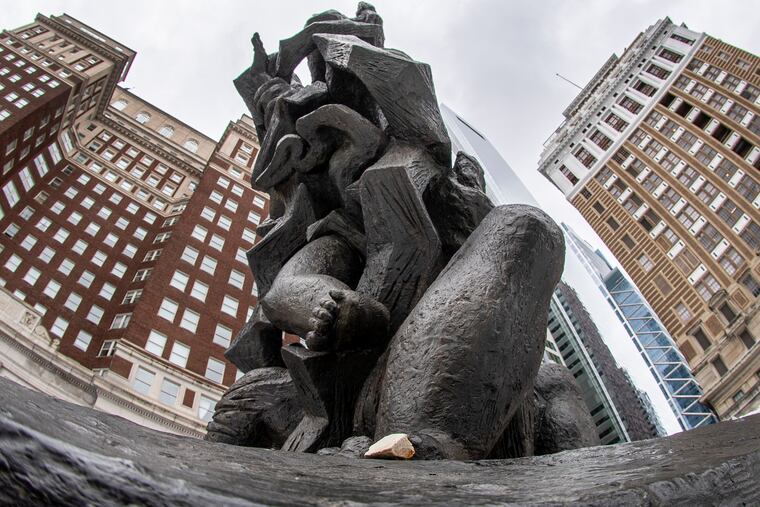The Holocaust Memorial Plaza will be adorned with a new mural in 2025
Berlin-based artist Ella Ponizovsky Bergelson will be the creative force behind it.

Last January, a wall adjacent to the Horwitz-Wasserman Holocaust Memorial Plaza was defaced with a sprayed-on swastika. Months on, community organizers are hoping a large-scale mural will stop more such acts and inspire community-wide unification.
On Tuesday, the Philadelphia Holocaust Remembrance Foundation and Mural Arts Philadelphia announced the placement of a 2,500-square-foot mural at the north end of the historic site — located at 16th and Arch Streets.
The privately funded mural will serve as a backdrop for the memorial plaza, complementing the 1964 sculpture, Monument to Six Million Jewish Martyrs by Nathan Rapoport, which stands at the head of the Benjamin Franklin Parkway. PHRF executive director Eszter Kutas wants the new mural to symbolize Holocaust history and combat discrimination of any kind.
“Our whole impetus for this project is to fight antisemitism and all forms of bigotry, and it couldn’t be more apropos than at this point in time,” Kutas said.
While similar acts of vandalism have transpired over the years, she said that there has been an uptick since Hamas’ attack on Israel on Oct. 7 last year.
The artist behind the mural will be Ella Ponizovsky Bergelson, who was chosen among 54 applicants, following a yearlong search. It is expected to be completed by September 2025.
Once completed, the mural will be the nation’s first large-scale, publicly commissioned mural dedicated to Holocaust remembrance and education in a public park, Kutas said. It will also be the first mural along the Benjamin Franklin Parkway.
Ponizovsky Bergelson, who has created murals at various venues worldwide, including an augmented reality installation at the 59th Venice Biennale in 2022, purposefully veered away from the traditional elements of a Holocaust memorial in her proposal.
Instead, her design focuses on the aftermath of the Holocaust, the displacement of millions of European Jews who were forced to move from their war-torn homelands to other parts of the world, including cities like Philadelphia.
“It’s not only my own life story, but it’s my heritage,” she said. “It’s where I come from. We were always on the move, and I choose to see it as a big privilege to be able to soak in all these different cultures, languages, and people in my life.”
Her proposed mural examines the personal, cultural, and linguistic effects of such a displacement, which she hopes draws parallels between Philadelphians in and outside the Jewish community.
Ponizovsky Bergelson, who moved from Moscow to Israel as a child after the fall of the Iron Curtain, and then later from Israel to Berlin, feels a strong connection to the theme.
Mural Arts executive director Jane Golden said the design, mostly text-based, will echo an “evocative” message about the current state of the world, and the things needed for the betterment of society.
“It’s a metaphor for today, and what all of us have to do as we grapple with having a better world,” she said.
Kutas hopes the new mural will educate visitors on the history of the Holocaust, unify people of different cultural identities, and deter vandals.
Golden said a special coating will cover the mural, making it easier to remove any graffiti or vandalism.
“It’s our hope the project will encourage reflections on lessons of the past, but also inspire people to think about what kind of future we want,” Golden said. “I’m hoping the weight and beauty of it, will make people appeal to their better angels and leave it be.”
To draw stronger community connections, Ponizovsky Bergelson said there are plans to “democratize” the creative process. While she has an outline of the project, she wants Philadelphia residents to contribute their own creative ideas.
This “elastic approach,” she said, is one of many ways to accurately reflect the people and varied communities of Philadelphia.
“We hope that people can see and find themselves, and not feel compelled to destroy it. But rather, to identify with it,” Ponizovsky Bergelson said.
To engage with the community, Ponizovsky Bergelson will be at the center of two in-person events on Dec. 8 and Dec. 11. There will also be a virtual gathering in January.
Attendees will have the chance to meet the artist, and learn more about the planned mural and the history of cultural displacement.
To register for the upcoming events, visit philaholocaustmemorial.org.